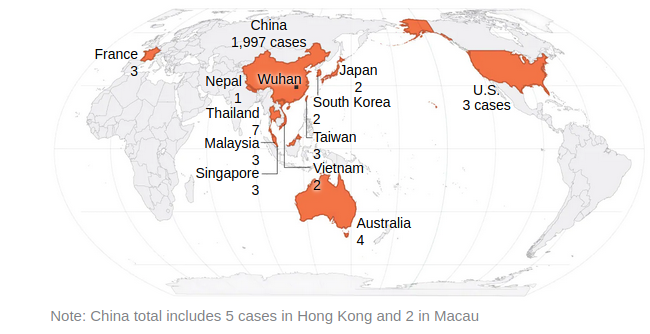There is growing concern that the new form of coronavirus, 2019-nCoV, is more dangerous than previously believed. Initial reporting indicated that there was little concern of a pandemic. Health officials in China, Japan, Korea, and the USA all indicated the potential for wide-spread infection to low, however, new reporting is showing more cause for alarm. The Washington Post reported a massive quarantine in China meant to help contain the dangerous virus.
The number of reported cases keep growing every day. So far, the virus has spread from Wuhan City, Hubei province, to Thailand, Vietnam, Singapore, South Korea, France, Australia, Japan, Nepal, the United States, and Taiwan. The first accounts of the coronavirus were not very alarming, leading many to believe that containment would not be much of an issue. However in recent days, that sentiment has changed. When news of the new virus broke, the number of infected was very low. Now, there are almost 2000 confirmed cases in China and the death toll has jumped to 56.
A recent article from The New York Times highlighted the concern for this virus to spread more ferociously than the SARS outbreak in the early 2000’s.
The director of China’s National Health and Health Commission, said on Sunday that the new coronavirus’s incubation period was about 10 to 14 days. And that period in which a virus is contagious is different from the SARS outbreak, said the director, Ma Xiaowei.
The rate of the current epidemic is accelerating, he said, and is “likely to continue for some time.”
The pressure is on to contain the outbreak with China building a new field hospital in Wuhan designed to treat patients suspected of contracting 2019-nCoV. Also, Chinese President Xi Jinping was warning residents to be prepared for the virus spreading rapidly. This high-level announcement stoked the fear in the already jittery nation. It was reported in an article from The Washing Post that there is now an effort to quarantine in China.
“More than 50 million people were ordered on lockdown in central China with a travel ban covering 16 cities in the central Hubei Province, where the virus was first encountered.”
The Washington Post has a useful tool to track and map the spread of the virus. It can be found here.
Here is the latest map from that site:

Even with the alarming news of the rapidly growing number of cases. The World Health Organization has yet to declare a global emergency. Despite the lack of an officially declared emergency, there is great cooperation in the international community to contain the coronavirus.
There are still contrasting views on the dangers of a pandemic. In China, where the death rate of those infected is about 4% and ‘severe’ infections are about 25%, officials are concerned. Another report on the outbreak from Yahoo News highlights the Chinese response.
After more countries reported cases, Xi said at a Communist Party leadership meeting on the disease that China was “faced with the grave situation of an accelerating spread of the new coronavirus” but that the country will “definitely be able to win the battle,” according to state media.
In the United States, where only 3 cases have been reported, most recently in Orange County, California, there seems to be much less worry. Efforts at some airports have been stepped up to monitor passengers coming from affected areas. Reporting from the local newspaper, The Orange County Register, highlights the response from the Orange County Health Care Agency and the CDC.
The Orange County agency said it, in consultation with the CDC and the state Department of Public Health, is following up with all people who have had close contact with the patient.
It said:
–The HCA will monitor any close contacts and assure that proper evaluation and care is provided if they become ill.
–The CDC’s guidance indicates that people who have casual contact with a case (such as in the same grocery store or movie theater) are at minimal risk of developing infection.
–There is no evidence that person-to-person transmission has occurred in Orange County.
“The current risk of local transmission remains low,” the agency said in a statement.Information about the coronavirus is on the OC agency’s website here.
Continued containment efforts will remain difficult as the incubation period for 2019-nCoV is about 2 weeks, where the virus can be spread while those infected remain asymptomatic. Efforts for containment in China are commendable. We will continue to follow this story and watch for updated information relating to infection rates and follow-up meetings from the WHO.
